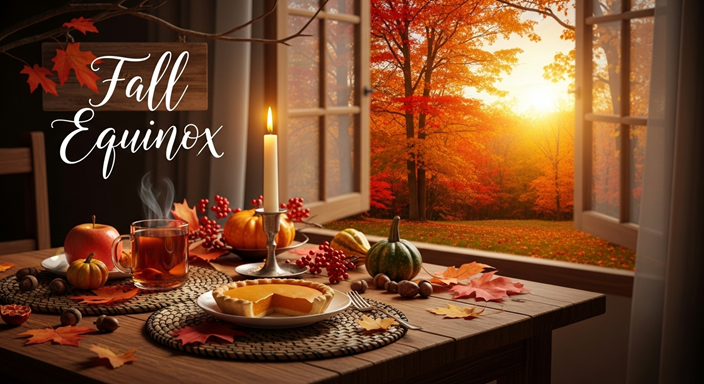The #FallEquinox, also known as the #AutumnalEquinox, is a #CelestialEvent that marks the official beginning of #Fall in the #NorthernHemisphere and #Spring in the #SouthernHemisphere. It occurs when day and night are nearly equal in length, symbolizing #harmony, #transition, and #balance. Cultures across the world have celebrated this day for thousands of years, connecting it with harvest festivals, spiritual observances, and seasonal rituals. The equinox encourages reflection on change, gratitude for abundance, and preparation for the colder months ahead. Fall Equinox is not just an astronomical occurrence—it is a celebration of balance in life.
History of Fall Equinox
The celebration of the Fall Equinox dates back to prehistoric times when early civilizations closely followed the movement of the sun, moon, and stars. Ancient people used stone structures like Stonehenge in England and Chichén Itzá in Mexico to track solar events, including equinoxes.
The Druids in Celtic Europe honored the equinox with rituals that symbolized the harvest and the cycle of life. In Japan, the equinox has been celebrated as Higan, a Buddhist tradition, for over a thousand years. Native American tribes, such as the Cherokee, also observed seasonal changes through ceremonies dedicated to harvest and thanksgiving.
The term “Equinox” itself comes from the Latin words aequus (equal) and nox (night), highlighting the equal distribution of daylight and darkness. While it is not attributed to a single founder or group, it became deeply ingrained in agricultural societies, as it indicated the time to gather crops and prepare for winter. In modern times, it has evolved into both a scientific milestone and a cultural festival worldwide.
Importance of Fall Equinox
The importance of the Fall Equinox lies in its ability to connect humanity with nature’s rhythms. For ancient farmers, this was a crucial marker: the time to complete harvests, store food, and prepare for the cold season. Spiritually, it represents balance—where light and darkness share the sky equally, reminding people of the need to find harmony in their lives.
On a global scale, the day highlights humanity’s dependence on natural cycles. It’s a moment that invites self-reflection, gratitude, and mindfulness. Communities and individuals use the equinox as a reminder that endings pave the way for new beginnings.
Significance of Fall Equinox
The significance of the Fall Equinox extends across cultures, religions, and traditions:
-
Agricultural Significance – Marks the final harvest of the year, a symbol of abundance and preparation.
-
Spiritual Balance – Serves as a reminder of duality: light and dark, life and death, beginnings and endings.
-
Cultural Identity – Different communities celebrate their own unique rituals, strengthening cultural heritage.
-
Astronomical Relevance – Helps scientists and ordinary people understand the Earth’s tilt, orbit, and relationship with the sun.
It’s not only about the science of equal day and night but also about the deep symbolic meaning of balance and transformation.
Why Fall Equinox is Celebrated
The Fall Equinox is celebrated because it embodies gratitude, balance, and change. For farming communities, it was historically a way to thank the earth for its bounty. For spiritual seekers, it represents finding equilibrium between light and shadow, both in the world and within ourselves.
It is also celebrated as a cultural heritage day—with festivals, music, food, and rituals rooted in generations of tradition. Some communities use it as a time for cleansing and renewal, preparing mentally, emotionally, and spiritually for the colder and quieter months that follow.
How Fall Equinox is Celebrated
Celebrations of the Fall Equinox vary across cultures but share common themes of harvest, gratitude, and balance.
-
Harvest Festivals: Communities organize fairs and feasts showcasing seasonal produce like apples, pumpkins, grains, and nuts.
-
Bonfires and Rituals: Many people light fires or candles to symbolize the balance between light and darkness.
-
Spiritual Observances: Meditation, yoga, and prayer rituals focus on grounding, gratitude, and harmony.
-
Cultural Festivals: In Mexico, thousands gather at Chichén Itzá to watch the play of sunlight on the pyramid of El Castillo, creating the illusion of a serpent descending.
-
Family Traditions: Families gather for meals, storytelling, and seasonal decorations to honor the day.
Modern celebrations often combine science, spirituality, and cultural appreciation, making it both ancient and contemporary.
Countries and Regions that Celebrate the Fall Equinox
The Fall Equinox is celebrated across continents, though with different customs and names:
-
United States & Canada: Celebrated with harvest festivals, apple-picking, and pumpkin traditions.
-
Mexico: Thousands gather at Chichén Itzá to observe the solar serpent phenomenon.
-
United Kingdom & Ireland: Druids and Pagans observe rituals at Stonehenge and other sacred sites.
-
Japan: Celebrated as Higan, a Buddhist holiday to honor ancestors.
-
China & Taiwan: Part of the Mid-Autumn Festival, featuring mooncakes and lanterns.
-
India: Though not directly named Fall Equinox, seasonal rituals are tied to harvest and lunar calendars.
-
South America: Indigenous tribes celebrate nature’s cycles with rituals honoring the earth.
These widespread traditions showcase the universality of human connection to nature’s balance.
How Citizens Involve Themselves in the Celebration
Ordinary citizens make the Fall Equinox special through both personal and community efforts:
-
Participating in Festivals – Joining fairs, food festivals, and parades.
-
Decorating Homes – Using autumn colors, pumpkins, and seasonal crops.
-
Practicing Mindfulness – Engaging in yoga, meditation, or journaling about personal balance.
-
Volunteering – Helping local farms, food banks, or environmental groups.
-
Spending Time Outdoors – Hiking, stargazing, or observing the changing leaves.
-
Honoring Ancestors – Through rituals, prayers, or cultural customs.
Their active participation ensures the equinox remains not just an event but a living tradition passed through generations.
Theme for Fall Equinox 2025
The proposed theme for Fall Equinox 2025 is:
“Harmony Within, Balance Without”
This theme emphasizes aligning inner balance with the external changes of nature. It reminds people to nurture harmony in their thoughts, relationships, and environment while respecting the seasonal cycles of the earth. The 2025 theme also encourages sustainable living—urging communities to adopt eco-friendly practices as they celebrate.
10 Famous Quotes for Fall Equinox
-
“The autumn equinox reminds us that balance is the key to life.”
-
“As light and dark share the sky, so must we share gratitude and grace.”
-
“The earth’s cycles are not endings, but renewals in disguise.”
-
“Fall teaches us how beautiful it is to let things go.”
-
“Equinox is nature’s way of teaching us equilibrium.”
-
“Harvest is not just crops—it is wisdom, love, and experience gathered over time.”
-
“In the balance of day and night lies the secret of harmony.”
-
“Fall Equinox is both a pause and a promise.”
-
“The beauty of autumn is that it prepares us for new beginnings.”
-
“The equinox is the earth’s reminder to honor both shadow and light.”
FAQs on Fall Equinox
Q1. What is the Fall Equinox?
The Fall Equinox is the astronomical event when day and night are nearly equal in length, marking the start of autumn in the Northern Hemisphere.
Q2. When is Fall Equinox 2025?
It falls on September 22, 2025.
Q3. Why does the Fall Equinox happen?
It occurs because of Earth’s tilt (23.5 degrees) and orbit around the sun, aligning the equator directly with the sun’s rays.
Q4. Is the Fall Equinox the same worldwide?
Yes, it occurs on the same date worldwide, though the seasonal meaning differs: fall in the Northern Hemisphere and spring in the Southern Hemisphere.
Q5. What is the spiritual meaning of the Fall Equinox?
It symbolizes balance, transition, gratitude, and renewal.
Q6. How long is the day on Fall Equinox?
Day and night are almost equal, usually about 12 hours each.
Q7. What foods are eaten during Fall Equinox celebrations?
Traditional foods include pumpkins, apples, squash, corn, nuts, and grains.
Q8. Do all cultures celebrate the Fall Equinox?
Not all, but many cultures have seasonal festivals and rituals tied to equinox or harvest times.
Q9. What’s the difference between Fall Equinox and Spring Equinox?
The Fall Equinox marks the beginning of autumn, while the Spring Equinox marks the beginning of spring.
Q10. Can you observe the Fall Equinox at home?
Yes, by meditating, journaling, decorating with autumn symbols, or simply observing the sunrise and sunset.
Conclusion
The Fall Equinox 2025 is more than just a celestial alignment—it is a call for balance, gratitude, and renewal. From ancient civilizations to modern communities, this day has always symbolized the deep bond between humans and nature. Whether through harvest festivals, spiritual rituals, or quiet personal reflection, the equinox invites us to pause and embrace life’s cycles with harmony. As the day and night share equal space, we are reminded to find equilibrium in our own lives. By celebrating responsibly and meaningfully, citizens worldwide can keep the timeless tradition of the Fall Equinox alive for generations.
|
!!! Stay Updated !!! 👉 Follow and Join us on 👈 📰 Trending News | 📢 Important Alerts | 💼 Latest Jobs LinkedIn | Threads | Facebook |Instagram | Tumblr 📱 Follow us daily & never miss an update 📱 |

Someshwar Chowdhury is a seasoned Chartered Mechanical Engineer, Educator, and Technology enthusiast with over a decade of experience in engineering education and consultancy. Someshwar is also an active blogger, trainer, and member of professional bodies like ISHRAE and GREEN ADD+. When not teaching or consulting, he enjoys blogging, music, and exploring green technologies.
Discover more from Today's Significance
Subscribe to get the latest posts sent to your email.
